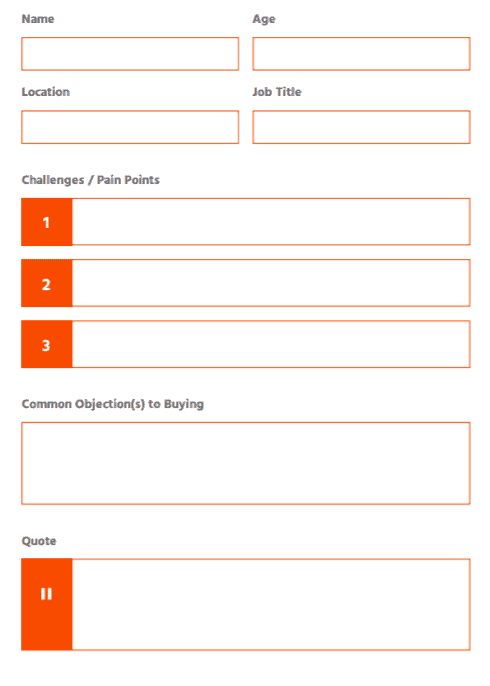For your business to succeed, you must deeply understand your customers. The best way to do that is to create a customer persona — several, in fact.
Your customer personas can focus your messaging, guide your marketing, and improve your product.
But what exactly is a customer persona and what’s the easiest way to create one?
In this guide, we’ll discuss everything you should know about creating customer personas. Let’s get started.
What Is a Customer Persona?
A customer persona is a fictional representation of your target customer. While your customer persona may be fictional, it describes a real person — the very person who will buy and benefit from your product.
Defining your customer personas will help you and your team understand your target audience better. When you’re trying to make the most of your marketing budget, it’s a good idea to know exactly who you’re talking to. A well-defined customer persona can help you answer questions like:
- What are your customer’s pain points?
- Why does your customer hesitate to buy your product?
- Where does your customer go to find their information?
If yours is like most businesses, you cater to different types of customers — even if you have only one product. This means that you need to develop several personas, one for each customer type.
Your product may be highly nuanced but you probably still have more than one customer type. For example, let’s say you sell customizable touring plans for Disney World. Are you catering to just one customer? Nope. If you look a little closer, you may have four types of customers:
1) Disney visitors with young children
2) Disney visitors with tweens/ teens
3) Disney visitors with no children
4) A combo of 1 and 2
But when you look even closer to those customer types, you may have:
1) Those who are interested in a one day/ one park plan
2) Those who are interested in a two day/ one park plan
Understanding each of these customer personas can help you fine-tune your marketing messaging. It will also ensure that your product answers your customer’s main challenges.
Don’t shy away from getting specific when developing your customer personas. Each customer persona has a name, background, and even a face. It is a distinct personality that represents all of the people in that subset of customers. And remember that the more “human” your persona appears, the better.
What Are the Main Benefits of Creating a Customer Persona?
It’s one thing to know your basic customer types in your head, but why should you take the time to flesh them out and give each of them a personality?
Two words: Personalized marketing.
If you want to reach your customers these days, you need to appeal to them on a personal level. No one likes generalized messaging. Your customers are attracted to solutions that target their exact pain points. They enjoy seeing content that’s written directly to them.
The best way to market your product is to have a personal conversation with each customer. But, let’s be real. That’s pretty impossible if you want to grow your business beyond a few customers. This is where customer personas come in handy. By segmenting your customers into separate groups, you can tailor your content so that it feels like it was written specifically for that customer’s needs.
Creating a customer persona enables you to:
- Specialize your marketing message so that you can speak to each customer type
- Craft better content on your blog and social media channels
- Develop better products that answer the needs of your customers
How Do You Create a Customer Persona?
Now that we’ve discussed the benefits, let’s get into the nuts and bolts of creating your own customer personas.
Start With Assumptions
When you start crafting your customer personas, you’ll need to make a lot of generalizations. It’s okay to start broad and then refine. Answer these two questions:
- Who do you think your customer is? (Answer with basic demographics such as age, job title, income level, etc.)
- What problem can you help them solve?
Now that you have the basics, get more specific.
Learn more about your target customers by studying your current customers. Conduct customer surveys and discover who your customers are and what challenges they may have. Also, talk to your employees to get a better picture of your customer base.
Check out your website’s analytics to find demographic data about your visitors. Google Analytics is free to use and can give you a lot of insight about your site visitors that you wouldn’t know otherwise. You can also do this on social media with analytical tools like Sprout Social.
Create at Least 3 Customer Personas
Armed with your list of assumptions, decide who your target customers are. Most businesses have at least three types of customers.
For example, a perfume business may sell to women directly, to men who wish to buy perfume as a gift for women, and to boutiques. Obviously, the marketing messaging will be different for each group which means this business should develop three personas to hone in their marketing message.
The same is true for most businesses.
Create an Identity
Choose a Name
- Every persona needs to have a name. Choose a name like Sally Homemaker or Techie Tim for your persona which will help you and your team summarize that persona at a glance.
Select Basic Demographics
- Age Range
- Location (Where does this persona live? Urban, suburban, rural? Local, a different country?)
- Job Title
- Income Level
- Education Level
- Family Type (Married, single, divorced, engaged? Kids, expecting?)
- Personality Type (Extrovert, introvert?)
Define This Persona More
- What is his/ her background? (Write a paragraph about this person’s history.)
- What are his/ her career goals? (If applicable, for B2Bs)
- What are his/ her challenges at work? (If applicable, for B2Bs)
- What are his/ her interests?
- What are his/ her favorite websites? (You can use this information for marketing purposes.)
- What are his/ her top 3 personality traits? (Pragmatic, dominant, indecisive?)
- What is his/ her preferred method of communication? (Phone, email, social media?)
Describe Challenges/ Pain Points
Why does this customer need your product? Make a list of common frustrations for this customer.
Describe the Persona’s Goal(s)
Keep the goals relevant to your product.
List Common Objections
What would prevent this customer from buying your product?
Add a Photo
Attaching an image can help with humanizing this persona.
Add a Quote
When discussing their pain point, what matters the most to this persona? For example, “I just want to have more quality time to spend with my family.” You can use actual quotes from customer surveys or interviews.
Continue creating personas until you have one for each of your customer segments.
An example of a customer persona’s survey:
Should you need help, contact us today!




